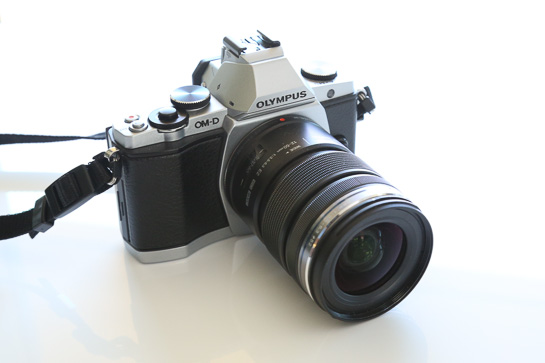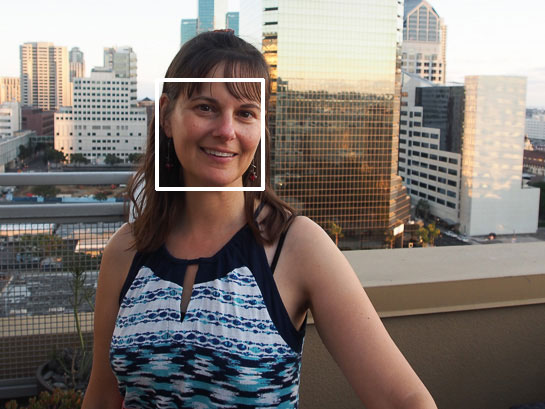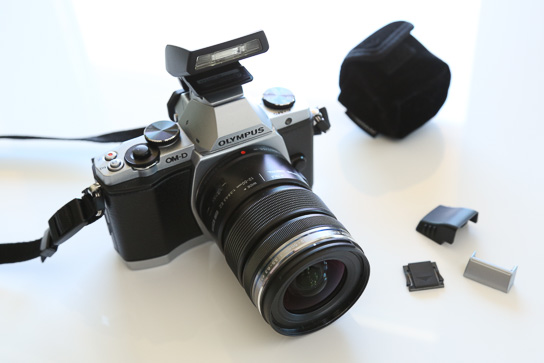 The new wave of compact, mirrorless cameras is the most exciting thing to happen to digital photography since…well, digital photography.
The new wave of compact, mirrorless cameras is the most exciting thing to happen to digital photography since…well, digital photography.
Cameras that perform like DSLR’s (well, almost) but without the weight, the bulk, and the backache are a welcome breath of fresh air in an industry that was starting to stagnate in a war of megapixels.
Last December I plunged into the mirrorless market by reviewing the remarkable Fuji X100S, and I updated that review in June after using the camera for six months.
And while I still think the Fuji is an astonishing camera — near perfect in many ways — its few shortcomings have sent me searching for an alternative, or at least an additional, small camera.
With so many options to choose from, it’s almost impossible to know where to begin, but I have one criterion that slashes the list:
A Viewfinder
I can’t stand trying to frame a photo in bright sunlight using the LCD on the back of a camera. For one thing, it’s all but impossible in bright light. And for another, I’d have to put on my reading glasses (yeah, I’ve reached that age).
So I’ve eliminated many candidates, and probably some excellent cameras, from my consideration by insisting that they have a real viewfinder (electronic, or optical, or both, it doesn’t matter, as long as there is something to put my eye up to).
Olympus OM-D E-M5
The Olympus OM-D E-M5 is part of the well-established “Micro Four Thirds” family of cameras. Cameras in this class have an image sensor slightly smaller than the APS-C sensor found in the Fuji (and in most crop-sensor DSLR’s), but still very large by comparison to traditional point-and-shoot cameras.
I chose the Olympus OM-D E-M5 for my second mirrorless camera because it fills some gaps left by the Fuji in my camera lineup.
Most Importantly
- Image Stabilization (in-body, 5-axis stabilization to reduce camera shake)
- Interchageable Zoom Lens (as compared to the Fuji’s fixed 23mm lens)
- Face Detection Auto Focus
Faces in Focus!
If you read my previous Fuji reviews, you know my chief complaint was its frequent failure to autofocus on the subject.
I’m happy to report that the Olympus does a much better job — and it even helps you by automatically detecting faces in your frame and focusing on them. Nice!

Olympus OM-D E-M5 Face Detection Auto Focus. A white square in the viewfinder shows faces detected by the autofocus system. Click to enlarge photo
It’s not perfect, but it’s a big improvement over the erratic performance of the Fuji.
Zoom Lens (and the option for more)
The Olympus allows interchangeable lenses, so it’s far more flexible than the Fuji with its fixed 23 mm lens. There’s a whole spectrum of micro-four-thirds lenses made by Olympus, Panasonic, and others that will fit on the OM-D E-M5.
So far, I’ve only used the kit 12-50mm (f/35.-6.3) lens, which is roughly equivalent to 24-100 on a full frame camera. This is a versatile range which serves nearly all my needs.

Olympus OM-D E-M5 – Zoomed in tight 50mm, f/6.3, 1/250 sec. Click here for a 100% crop.
Of course, the downside to a zoom lens is you’re just never going to get the quality you can in a prime lens. And when compared to the near-miraculous prime lens on the Fuji, this Olympus kit lens comes up a little bit shorter on quality. But that’s not really a fair comparison, because the Fuji can’t zoom.
And for a kit lens that zooms, the Olympus 12-50 is really quite good. I’d like to try a wide-aperture prime lens on the Oly (perhaps a f/1.2 of 1.4) to see what it’s really capable of, and I’ll expand this review in the future if I do.
Meanwhile I’m basing my opinion on the 12-50 kit lens.
Stabilization
You know I’m a fan of stabilization. Every one one of my Canon lenses is stabilized, because I have shaky hands, and I find it greatly improves my images.
Olympus took a different path and stabilized the camera a body (actually the sensor), rather than the lens. This has a couple advantages. The lenses are less expensive and smaller without the extra moving parts. And any lens you mount, from any maker, still benefits from the in-body stabilization.

Olympus OM-D E-M5 – Chimney Rock in Asheville North Carolina. 12mm, f/3.5, 1/1000 sec.
Click to enlarge
Some users complain that the Olympus makes a humming noise when stabilizing, but frankly I don’t find it noticeable.
I configured mine to stabilize then the shutter is half-pressed (rather than the default instantaneous stabilization when the shutter is clicked) because (a) I like to see the effect in the viewfinder to know it’s working, and (b) I don’t really trust it to be able to stabilize that fast.
Of course, I pay for this option in battery life, but I always carry a spare, and still find I can usually get a normal day’s shooting from one battery.
PROS
The biggest benefits of the olympus are three mentioned above:
- Image Stabilization
- Interchageable Lenses
- Face Detection Auto Focus
Other great features:
- Tilt-out rear LCD screen (great for framing high or low angle shots)
- Touch-screen control
- Compact body size (slightly smaller than the Fuji — until you attach a lens)
CONS
- Ridiculous name (come on Olympus, “OM-D E-M5”? Really catchy. Why not THX1138?) I still have to look it up the spelling every time I write it.
- Cumbersome flash – The E-M5 has no built-in flash. Instead, it comes with a little hot-shoe flash that you can mount on top. When it’s mounted it works well enough, but attaching it requires removing three (three!) little plastic widgets from the camera and flash (little widgets which you must then keep track of). The flash comes in a little velvet carrying bag which can be attached to the camera strap, and I use it to store the little fiddly bits when the flash is mounted. But overall, it just seems like too much of a hassle to mount the flash.
- Non-Intuitive Controls – I’m still struggling to get familiar with the E-M5, despite having read the manual (much of it twice). For some reason, it just doesn’t want to gel with me. Of course, the Fuji also has a steep learning curve, but somehow it’s easier to just pick it up and do things with than the Olympus. My shooting-partner Julie also finds the Olympus a bit frustrating. For example, we couldn’t figure out how to delete all images from the memory card without consulting the manual. I often feel like, “I just want to do X! Why should I have to look at the manual to do X?” Of course, if the Olympus were my main camera, I’m sure I’d come to know it backwards and forwards, and this problem would go away. But for now, I still struggle with it.

Olympus OM-D E-M5 with flash mounted. (And the little fiddly bits that you have to remove, and avoid losing, when you mount it.)
Compared to the Fuji X100S
So, now that I own two of these little mirroless wonders, which do I prefer? Well, the answer of course, is:
It depends.
If your primary photography need is shooting quick, reliable snapshots of people, especially on the move, then the Olympus beats the Fuji, because its face-detection autofocus is simply more reliable. And the stabilization helps avoid shake. So for family vacation photos, shots of the kids in action, etc., you might prefer the Olympus.
And if you want a zoom lens, or to attach different lenses for different purposes (especially telephoto), then the Olympus wins hands down. Because the Fuji is always fixed at a fairly wide 23mm.
But if your main concern is image quality, or the convenience of a self-contained one-piece camera (even if you have to spend a little more time getting the shot) then the Fuji still reigns supreme.
There is a good reason why many expert photographers and gearheads (such as David Hobby, Zack Arias, and Ken Rockwell) call the Fuji X100S the best digital camera they have ever owned. The image quality of the Fuji is simply astonishing.
So, I would summarize the strengths of each camera as follows:
Olympus OM-D E-M5 Strengths:
- Easy people snapshots
- All-purpose walk-around versatility (zoom lens)
- Ability to use telephoto and other lenses
- High/Low Angle shots (tilt-out-screen)
- Stabilization prevents camera shake in stills and video
Fuji X100S Strengths:
- One-piece camera. No extra lenses or flash needed.
- Super-sharp photos (especially with manual focus)
- Tricky flash situations (leaf shutter = sync at any speed)
- Low light shooting (f/2 lens)
How I Decide Which One to Carry
Here’s the way my decision process is starting to go when I’m running out the door and have to decide which camera to grab:
If I’m going to be primarily shooting people, I go for the Olympus. For example: Recently my daughter and I went to Comic-Con, which is all about getting photos of costumed people, most of them in motion, frequently shot while I’m also in motion. The Olympus is a no-brainer for this, because the Fuji would miss the focus on half of these moving people. The Olympus, with its face-detection auto-focus, makes these rapid-fire moving snapshots much more reliable.

Olympus OMD EM5 – Face detection autofocus even worked here! Click here for a 100% crop.
On the other hand, when I want to shoot an object, like a flower, or a plate of food, especially in low light, and I have all the time in the world to focus, I choose the Fuji. Especially if I want a really shallow depth-of-field for an artistic look, because the f/2 lens gives a beautifully soft background.
So, as with all things in photography, it’s a trade-off. I think that if the Olympus 12-50 zoom lens had an aperture of f/2.8 throughout its range, it would be almost the perfect camera. Or, if the Fuji could zoom and had more reliable autofocus, then it would be the perfect camera.
I love shooting with both of these cameras and wholeheartedly recommend both of them. If you are in the market for a compact camera with great performance, you can buy either of these with confidence and expect to get a lot of joy from it.
But I still don’t feel like I’ve found the “perfect” small camera for me — if such thing even exists. Maybe I’m on a unicorn hunt and doomed to be disappointed.
But for now I’m going to keep hunting, and I’ll let you know the results as I go.
Price these cameras on Amazon.com
Olympus OM-D E-M5 on Amazon.com
(And by the way, if budget is no obstacle, Olympus has subsequently released a newer model in this camera line, the Olympus OM-D E-M1, which reportedly has better image quality. Add the Olympus Zuiko 12-40 f/2.8 lens and you have what sounds very much like my fantasy scenario described above, but the total cost is about $1,000 more than my Em5 package.)
As always, when you shop from my Amazon links you buy me a beer!





Hi Phil,
Great review, thank you. I have the Fuji X100 which has the same brilliant lens as the 100s but is a little slower to use and has all the drawbacks you mention when it comes to moving targets. So I have just added a Fuji XE-1 to my stable. You might want to take a look at one. I don’t know that it’s necessarily better than the Olympus, except that I’m willing to bet the lenses (especially the zooms) are superior, and it does have a larger sensor.
Best wishes
Michael
Phil,
Always love your articles and reviews. I think, however, there is a better camera than the OM-D E-M5…the OM-D E-M10. Why the EM10? Because it has all the EM5 has, plus a built-in flash. Further, it has the same sensor as the EM1 (and no AA filter). As a matter of fact, it has virtually EVERYTHING the EM1 has, with a couple of exceptions (contrast AF vs phase-detection and 3-axis stabilization vs 5-axis). I was VERY impressed with its capabilities and have added it to my repertoire (for big jobs, Nikon D610…for everything else, EM10). It deserves a look…if you like the EM5, I believe you will love the EM10.
Thanks again for all your great work…
Respectfully,
Frank Villafane
Urban Industrial Imaging
Hi Phil, thanks for the review. Took your lightroom class after years of good intentions never getting the “picture”. Thanks, you have a calm way and pleasant way of speaking. Have been an Olympics user for 10 years working my way up to the OM-D5..It’s complicated all the guts of it..Just bought the 60mm macro.. pretty neat. I have two photos on the Olympus website.. They chose a sunflower for their Sept. 09 calendar, and another Zion photo I think in 2013.. Pretty exciting for an amateur. I am not a “big time” photographer and a little late to the game but my heart is really there. Just did the blog, my photos look pretty good. Thanks again. Anne up north from you in San Clemente.
Michael, the XE-1 is also on my short list of interesting cameras to try, along with some of the new Sony models.
Frank, thanks for mentioning the EM10, which I had not even looked at yet. Sounds very promising, and I appreciate your summary of its features.
So many cameras, so little time!
Yes, the Olympus menu can be confusing if you are not familiar with, but remember, the interface was designed three or four years ago. It is not disorganized. If you wanted to delete all the pictures from your card, it is common sense and safer to format the card. As far as the plastic “bit”, the electronic covers for the flash and shoe, look at the Fuji X-T1… A similar setup. The comparison of the X100S would have been more appropriate if it was compared with the X-E2: same size sensor, interchangeable lenses. The Olympus OMD EM-5 is an excellent camera that can hold its own against the Fujis, but the two Fujis in many ways are more similar to each other barring the lush utters. You could have reviewed the excellent 23mm lenses of both models and the incredible catalog of lenses, primes and zooms for the interchageable lens models. The Olympus primes are fantastic as well… The 17mm (equivalent to 34mm in field of view) to the 23mm Fuji (equivalent to 35mm in f.o.v.). A better comparison there since the Olympus 12-50 is okay whilst the 12-40 f2.8 pro would be a better comparison for image quality.
While I am not saying you could not compare as you did, if you are reviewing an I.LC. Vs a C.S.C and the convenience, the the two Fujifilm models would have been more appropriate.
Thanks for the hard work!
Arbee88
Hi Phil, Thank you for the review! I’m looking at the LYTRO Illum. Do you have any thoughts on this one?
Henry
Another great real life review, thanks Phil, you always inspire me to shoot more. And I love your training. Go for the Fuji X-T1 and you won’t need to review anything else, its a giant killer! Cheers Paul
Henry, as for the LYTRO, I think the technology is amazing. But I still can’t decide whether it’s going to revolutionize photography or just turn out to be a novelty (remember when adding “scent” to movie theaters was going to revolutionize the film experience?) If you get the camera, be sure to let me know how it goes!
Agree with comments. There is quite a bit of moiree without the AA filter.I have used the original OM -D The first packed up straight away with a faulty screen together with the 300 mm lens but they were quickly replaced and I’ve had no subsequent trouble despite extensive use over the last 3 years. Since I’m a wildlife photographer I carry my trusty 400 mm prime on canon 5d2 but have the Olympus around my neck with the 9-18 zuiko for those special landscape and people shots. I hate the viewfinder and seldom use it.If you tap on the screen to take the photo it will focus and light adjust where you tap….brilliant
But you can’t adjust the distortion in Lightroom as this camera doesn’t seem to be included in Adobes lineup.
It’s too slow for bird photography with tele extender to 600 mm
My 2 cents worth. I love it though
Thanks for the review Phil and may I say I’ve learnt a lot from your Lightroom class.
I’ve now switched from a Canon APS-C to the Olympus EM-1 (weight issues mainly) and was interested in your take on the EM-5. Of course, it’s horses for courses and no camera is perfect but when talking about IQ on the EM-5, the kit lens doesn’t do justice to the body. Try the 12-40 mm f2.8 PRO or the prime 75mm f1.8 lenses for IQ! Expensive but awesome.
It’m going to toss my vote in with a few others and wonder why you didn’t review the Fujifilm X-T1 as a comparison? Don’t get me wrong: the M43 camp has a lot going for it, and the in camera stabilization I’m sure is wonderful, but I feel like the X-T1 is closer to what you want based on your review here…
I bought a OMD EM5 pro kit here in Australia on a recent cashback promo offer along with 12-40mm f2.8. Now I also own the legendary 75mm f1.8. Woohoo!
I think its the best zoom i have ever owned ( yes I own Nikon 24-70mm and 70-200mm VRII ), its just so crisp and the 75mm is just ridiculously good.
I think I will be selling my Nikon 70-200mm VRII soon 🙂 and keep just a 24-70mm and get a 85mm for my D600 when i need those “bokeh” shots.
The camera’s UI is worst I have ever seen, but I have now learned how to use single point AF on EM5 also- like I prefer on all my cameras and I always shoot at widest aperture, hence always on Av mode and the metering always nails it.
The Image stabilisation is just amazing – i can get one handed hand held shots at shutter speeds like 1/2 seconds while tapping on the LCD to focus and shoot just like taking a photo on phone. Just amazing!
The live view gives you a great idea about exactly what the photo will look like – which is something I really miss on DSLRs now that I have been spoiled by a good EVF.
I don’t bother with RAW as the JPG’s from the olympus jook just right.
Nice review.
I took the plunge and settled on a different one, and it’s darn near perfect. So much so, in dact, that I leave my Nikon D800 home most of the time. Lens quality is very close to my Leica M3 and Leicaflex. I am having a blast with the Fujifilm X-T1.
I second Paul Talbot’s comment. I would request Phil to compare Olympus OMD EM5 to Fuji XT1
Hi All!
My view here is the Fuji X-T1 loses out on the Flash Synch speed to Olympus. No-one has mentioned this here yet!
The Fuji has the better quality sensor though.
The Olympus can now shoot at 100iso(Low) due to latest firmware update but, I think the Fuji is 200iso?
I shoot a lot of off camera flash so, purchased the Olympus EM5 and EM1 for this simple reason.
I also have a Canon 5D MK3 but find I seldom use it after getting spoilt by the Olympus 4/3rds system, weight-lighter, focus speed- lightening fast.
Images can be viewed on my facebook page, which I use as my blog.
Keep up the good work Phil!!!
Hi Phil,
I use a Samsung NX20 mirrorless camera and love it. The prime lens they make for it are wonderful, especially the 30mm F1.2. Some of the lenses have OIS ( like the 50-200mm zoom), but not all. The camera does have an “anti shake” feature though.
Samsung seems to get a bad rap when it comes to cameras, but I’m telling you they are awesome, and the bodies are so reasonably priced it allows for a wide range of lens purchases. Mine has a viewfinder (not all models do, but that was a must for me as well)
DPreview has a forum dedicated to Samsung NX cameras users. You should check the out 🙂
Just thought I’d throw that out there to consider a black sheep of the family camera!
May I have your comments on the Canon SX 50 HS
We had several SLRs and did not like the time required to take photos.
The SX 50 is light, fast & dependable and takes amazing photos both Macro & distant.
Thank you…..we have learned much from your articles.
Conrad
Always enjoy your reviews Phil , Iv just bought the fuji xt 1 . Im looking forward to working with it , I love the picture quality of Fuji and by all accounts (reviews ect ) The xt 1 performance is much much better . First impressions I love it already !
Just read your blog on the OMD EM-5 and thought you might like to know that earlier this year I took the plunge and changed my OMD EM-5 for the EM-1… All I can say is wow! such an improvement in so many ways compared to the OM-5. Coupled with the 12-40mm 2.8 zoom, Panasonic 25mm 1.4 prime, Olympus 45mm 1.8 prime and a 75mm 1.8 prime it’s an amazing outfit to work with and not anything like as heavy and bulky as my old Canon 7D outfit. All that is missing is a high quality long zoom, so at present am using the Panasonic 45-200mm.
Thanks very much for the illuminating reviews, Phil. Does anyone know if stock agencies have any restrictions on these compact mirrorless cameras? I’m interesting in getting into stock photography and have been looking at the Olympus OM-D E-M1, but hesitated because I heard agencies won’t accept submissions from these cameras.
I would love to see one of your reviews on the Sony A7… Mirror less with full frame sensor and ability with after market adapter to use Canon L glass.
I would love a review of the Sony Alpha a6000 vs this Olympus. My good friend and pro photographer working NYC is currently raving about the a6000. I noticed that it, too, has a viewfinder.
Have you looked at the a6000?
Thanks for your great reviews, you are a treasured resource.
Mahalo from Maui!
Thanks for your venturing into mirrorless cameras. I look forward to your thoughts on Sony Nex 6.
I am a passionate hobbyist photographer. I have been shooting M43 for years. (I also have Nikon DSLR and SLRs). M43 has been my go-to travel and adventure kit. I purchased a OM-D EM-5 Mii to replace my aging Panasonic DMC-G1. I love the OM-D. It quickly became my walk around all around carrying camera. I also have a Z7 but I use the OM-D much more than the Z. I’m wondering if I should go all M43 for digital work.